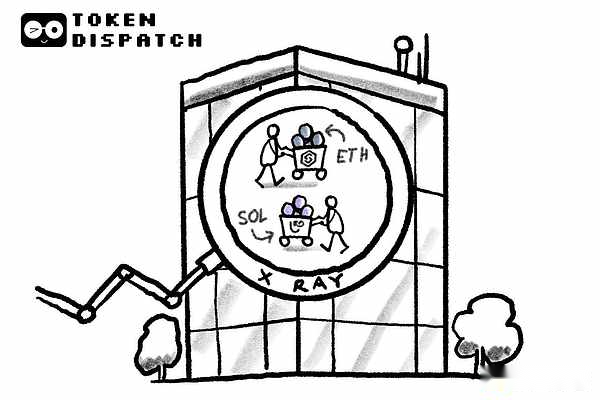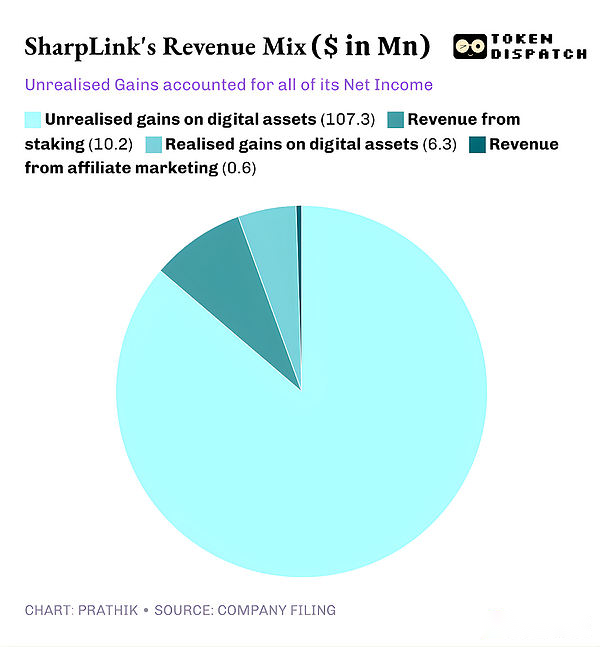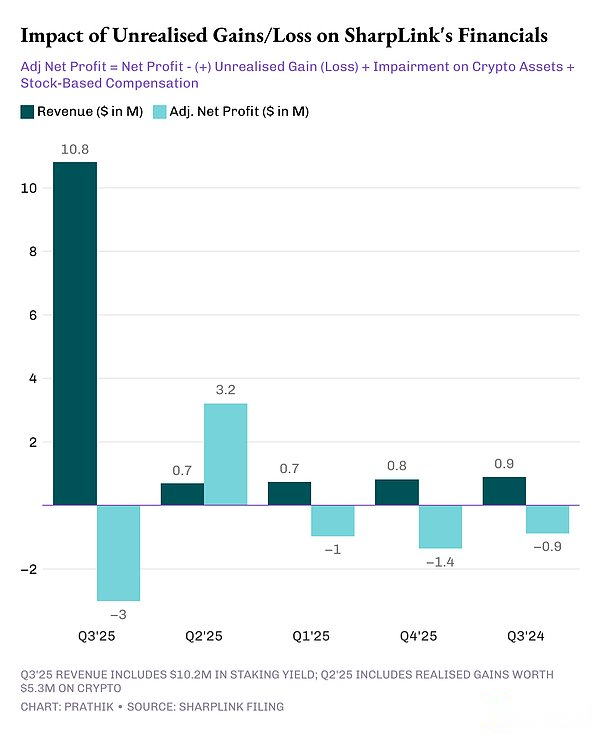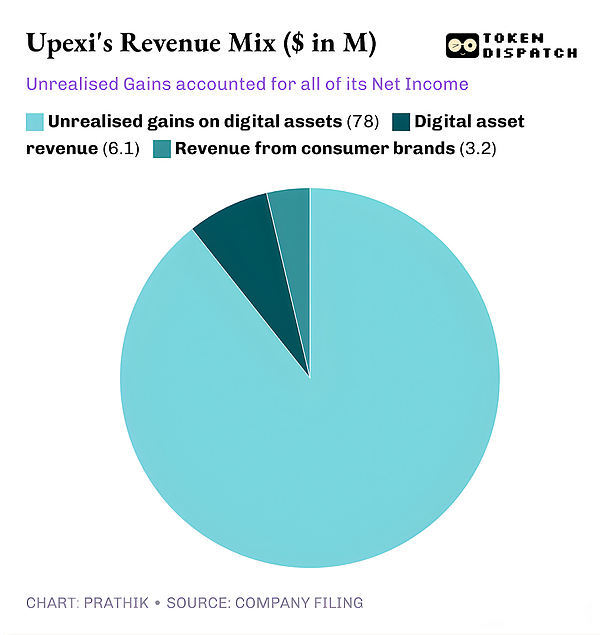
Author: Prathik Desai, Source: Token Dispatch, Compiler: Shaw Bitcoin Vision
I really don’t know how I’ve been holding on lately.The overwhelming number of financial statements almost overwhelmed me.I am now beginning to doubt my love for numbers.Not because it’s too much analysis, but because each of the last six earnings analysis reports I’ve written in the past three weeks has revealed something rarely seen in corporate financial statements.
The financials of digital asset treasury (DAT) businesses are intricately intertwined with decentralized finance (DeFi) strategies, making analyzing a company’s financial performance challenging.
Upexi and SharpLink Gaming recently reported quarterly earnings, and they’re the latest companies I’ve dug into their financials.
On the surface, they appear to be ordinary businesses: one sells consumer brands, the other does sports betting affiliate marketing.But only after in-depth understanding will you find that it is not the warehouse or e-commerce platform, but the cryptocurrency that really affects their valuation, determines their profitability, and shapes their overall image.
Upexi and SharpLink enter a space that blurs the lines between corporate finance and cryptocurrency money management.

This article will take you through what I found interesting in Ethereum and Solana Treasury Reserves, and what investors need to be aware of before getting into cryptocurrencies through these avenues.
SharpLink’s ETH Trading Desk
Less than a year ago, I would have described SharpLink as a niche sports league marketing company, the kind of company only remembered during the Super Bowl.Its financials look like those of its mid-sized peers: revenue is meager, performance is subject to seasonal fluctuations in the sports calendar, and profitability is often poor.
There’s no indication it has $3 billion on its balance sheet.
That all changed in June 2025, when the company reinvented its image with a decision: to designate Ethereum as its primary treasury asset and become one of the leading companies holding Ethereum.
The company has since reorganized around its Ethereum management business and is led by Joe Lubin, co-founder of Ethereum and founder and CEO of Consensys.He joined SharpLink at the end of May as chairman of the board.
Over the past few months, SharpLink has shifted its business focus to Ethereum by investing funds directly into native staking, liquidity staking, and DeFi protocols.Three months later, the transformation is beginning to bear fruit.
SharpLink reported quarterly revenue of $10.8 million, an 11-fold increase from $900,000 in the same period last year.Of this, $10.2 million came from staking revenue from its ETH reserves, while only $600,000 came from its traditional affiliate marketing business.

SharpLink’s total assets grew from $2.6 million on December 31, 2024 to $3.0 billion on September 30, 2025.
At the end of the quarter, Sharplink held 817,747 ETH, which increased to 861,251 ETH by early November.Today, it is the second largest holding of ETH.This capital reserve alone helped increase its revenue 11 times.
This quarter, nearly 95% of SharpLink’s revenue came from the proceeds from its Ethereum staking.Although its net profit surged 100 times to US$104.3 million, compared with a net loss of US$900,000 in the third quarter of 2024, there is a problem hidden in it.Like most other DATs, SharpLink’s entire profit comes from unrealized gains on its ETH holdings.

This is because U.S. generally accepted accounting principles (GAAP) require companies to value assets at fair market value at the end of the accounting period.Affiliates’ contribution to profits is minimal.
So, all of these unrealized gains are non-cash in nature.Even the revenue SharpLink receives from staking rewards is paid out in ETH, rather than regularly converted to fiat currency.This is what worries me.
Although the non-cash income still counts as revenue for accounting purposes, the company still burned through $8.2 million in operating cash in the nine months to cover payroll, legal and audit fees, and server costs.
Where do these dollars come from?
Like most other DATs, SharpLink funds its ETH accumulation through the issuance of new shares.The company raised $2.9 billion this year through stock offerings and then offset dilution with a $1.5 billion share repurchase authorization.
This is a repeat of the DeFi flywheel effect, which is increasingly common in DATs.
SharpLink issues shares and uses the proceeds to purchase ETH.It stakes ETH to earn revenue, recognizes unrealized gains as the price of ETH rises, and reports higher accounting income, which gives it the ability to issue more shares.And so on.
As I’ve mentioned in other DAT cases, this model works well in up cycles.This model works well even after several bear market cycles, as long as the company’s cash reserves are sufficient to sustain spending.The increase in the price of ETH will enhance the balance sheet, the value of the treasury reserves will grow faster than the operating costs, and the market will also be able to obtain an Ethereum liquidity public agent with strong liquidity and rich income structure.
This vulnerability manifests itself when prices move sideways for an extended period of time, which is nothing new to Ethereum holders, coupled with high business costs.
We see similar risks in the case of Bitcoin treasury reserve giant Strategy.
I would expect almost all DATs to be exposed to these risks regardless of which cryptocurrency they invest in, unless they have strong cash reserves and healthy profitability to support their DAT reserve strategy.But rarely do we see profitable companies go all-in on cryptocurrencies.
We saw this happen when Strategy chased Bitcoin and SharpLink bet on Ethereum.The situation with Solana’s treasury reserves is much the same.
Upexi’s Solana Factory
SharpLink has almost completely transformed from an affiliate gaming company to an Ethereum treasury, while Upexi has adopted a Solana reserve strategy even though it still retains its old appearance as a consumer brand company.
I have been following Upexi for a while.From an operational perspective, they have been profitable in four of the past five fiscal years.Their brand acquisitions and revenue growth are both good, and their gross profit margins are also satisfactory.But as a business, Upexi has posted a net loss in each of the past four years.
Perhaps this is what prompted the company to include digital assets in its financial statements.Over the past two quarters, this shift has been subtle but visible.And during the quarter, digital assets dominated the company’s financial statements.
In the third quarter of 2025, Upexi’s revenue was US$9.2 million, of which US$6.1 million came from SOL staking and the remaining US$3.1 million came from its consumer brand business.For a consumer goods company that had zero revenue from cryptocurrencies last quarter, having two-thirds of its revenue coming from digital asset staking is a huge leap.

Upexi currently holds 2.07 million SOL worth over $400 million, approximately 95% of which is pledged.This quarter alone, they received 31,347 SOL staking rewards.
What differentiates Upexi from other DATs is its strategy for acquiring locked SOLs.
The company purchased approximately 1.05 million locked SOL at an average price of 14% below the market price, with an unlocking period from 2026 to 2028.
Locked tokens cannot currently be sold and therefore trade at a lower price.As these locked SOLs are unlocked, their value will naturally rise to the same level as normal SOLs, allowing Upexi to both earn staking rewards and gain built-in price appreciation from these SOLs.
This strategy is typically found in funds rather than general DATs.But when you look at Upexi’s cash flow, you see the same problem as SharpLink.
Although Upexi posted a net profit of $66.7 million on $78 million in unrealized gains, its operating cash flow was negative $9.8 million.Since SOL’s staking proceeds are not converted into legal currency, they are still non-cash proceeds.So the company did what fund-first DATs usually do: raise capital.

Upexi raised $200 million through convertible debt and secured a $500 million equity financing facility.Its short-term debt increased from $20 million to $50 million.
Same flywheel, but similar risks.What would happen if SOL cooled down for a year?
Both SharpLink and Upexi are building some neat products.But that doesn’t mean they are necessarily sustainable.
no easy answer
There’s a pattern here that I can’t ignore: Both companies run financial systems that make sense when economic times are favorable.They have both built treasuries that can scale with network activity; they have developed revenue structures that can supplement revenue streams; and, through these initiatives, they have become the top public agents of two of the most important Layer-1 blockchains in the world.
However, both companies make almost all of their profits from unrealized gains, earn token revenue that is illiquid, have no indication that they will liquidate their holdings to achieve systemic profitability, have negative operating cash flow, and rely on capital markets to pay their bills.
This is not just a criticism, but a reality and trade-off that every company that decides to adopt a DAT architecture must face.
In order for this model to continue, one of two things must happen: either staking must become the cash flow engine for enterprises to continuously raise funds to purchase digital assets; or enterprises must incorporate planned sales of digital assets into their digital asset trust strategies to achieve systemic profitability.
This is not impossible.Sharplink earned $10.3 million by staking ETH, while Upexi earned $6.08 million by staking SOL.
These are not small numbers.Even if some of it is reinvested into fiat currency to support operations, the situation may change.
Until then, both Upexi and Sharplink face the same dilemma: balancing extraordinary innovation with capital market liquidity.






